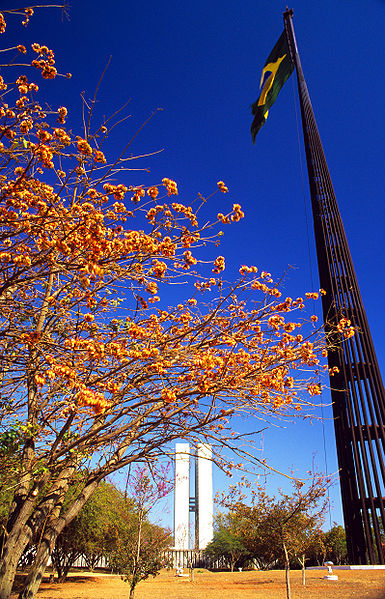Who hasn’t
heard of the Marvelous City? It is the city that draws up Brazil for its stereotypes
and stunning beauty. Rio doesn’t disappoint anyone who comes to see the mix of
an urban center and a beach town, with it touristic icons like the colossal Christ the
Redeemer and Sugarloaf Mountain and the famous beaches of Copacabana, Ipanema and
Barra da Tijuca.
Christ, the redeemer and Corcovado hill
For being the
capital of the country for more than a century and a half, the city preserves
historic Brazilian landmarks with its monuments and museums, and enormous
French influence. Rio was also the precursor of innumerous cultural movements
that left behind roots, such as the creation of samba and bossa nova, for
example. Its festivals, like carnival and New Year’s Eve, are reason enough to
highlight the city as an unforgettable destination.
National Library of Brazil, downtown - photo by Eliana Souza
Opera House - photo by Eliana Souza
Modern Art Museum, side view in Niteroi, 11 km or 7 miles away from Rio
designed by architect Oscar Niemeyer - photo by Eliana Souza
Carnival parade - from wikipedia
But, nothing
is more impressive than the relationship between people from Rio, or Cariocas, and soccer, which is
practically considered a religion. The four big teams in the city, Botafogo,
Fluminense, Vasco and Flamengo, are venerated by their followers and cause
commotion in their highly disputed games. It is estimated that 30 million fans
root for Flamengo, considered the most popular team in the country. Players
that have reached international fame, like Jairzinho, Garrincha, Rivelino,
Zico, Ronaldo and Romário, all played for one of these teams.
The home of
the giant Maracanã stadium which has hosted around 155 thousand fans, it is
there that games between the four rival teams are played. The stadium was
inaugurated shortly before the 1950 World Cup, in order to be recognized as the
biggest in the world. Five of the six games that Brazil played in the
tournament took place there, including the historic final against Uruguay, when
Brazil was beaten 2 to 1, and generated a national state of shock, which is
difficult to wipe from the memory of Brazilians.
Maraca, as it is affectionately called by locals, is the stadium that has
hosted the most games played by the Brazilian national soccer team. Several
final games in the Brazilian championships, and many historic games, there also
played there, like the incomparable soccer player Pelé’s game where he made his 1000th
goal, and his last game as part of the national team.
The final and decisive game of the 2013 Confederations Cup between Brazil and Spain will take place in the cathedral of football, as some people like to refer to the stadium as well.
Totally remodeled with a capacity for 79 thousand spectators, the
stadium will be the stage for the final game of the World Cup in 2014. It will
also host four games in the first phase, one of the round of 16 and another in
the quarterfinals. In addition to that, it will be the place where the
Confederations Cup in 2013 will be decided.
A little bit of Pelé with his testimonial
The final and decisive game of the 2013 Confederations Cup between Brazil and Spain will take place in the cathedral of football, as some people like to refer to the stadium as well.
Maracanã stadium during the Panamerican games opening in 2011 - photo by Roberto Stuckert-PR , Agência Brasil
Maracanã stadium - photo by Arthur Boppré during helicopter flight
The city of Rio de Janeiro will still be in the lime light in 2016, when it will welcome the next Olympic Games. Engenhão stadium, built for the Pan-American Games in 2007, is the home of Botafogo, and will also be used in the Olympic games in 2016.





























